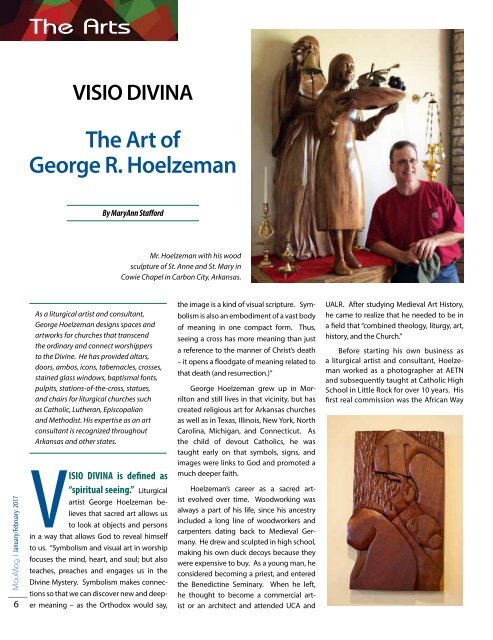A Foggy Day at Lake Willastein
17A4WxOkV
17A4WxOkV
Create successful ePaper yourself
Turn your PDF publications into a flip-book with our unique Google optimized e-Paper software.
VISIO DIVINA<br />
The Art of<br />
George R. Hoelzeman<br />
By MaryAnn Stafford<br />
Mr. Hoelzeman with his wood<br />
sculpture of St. Anne and St. Mary in<br />
Cowie Chapel in Carbon City, Arkansas.<br />
of the Cross for St. Augustine’s Church in<br />
North Little Rock. For this work, he received<br />
the N<strong>at</strong>ional BENE Award for Excellence<br />
in Liturgical Art and Design. He<br />
considers it one of his most significant<br />
cre<strong>at</strong>ions.<br />
Ambo, tabernacle support, chairs, and altar from Our Lady of the Holy Souls Church in Little<br />
Rock: simplicity with elegance. The life- sized st<strong>at</strong>ue in the Memorial Chapel of th<strong>at</strong> church is<br />
of Our Lady of the Holy Souls, and is made from basswood.<br />
January/February 2017<br />
6<br />
As a liturgical artist and consultant,<br />
George Hoelzeman designs spaces and<br />
artworks for churches th<strong>at</strong> transcend<br />
the ordinary and connect worshippers<br />
to the Divine. He has provided altars,<br />
doors, ambos, icons, tabernacles, crosses,<br />
stained glass windows, baptismal fonts,<br />
pulpits, st<strong>at</strong>ions-of-the-cross, st<strong>at</strong>ues,<br />
and chairs for liturgical churches such<br />
as C<strong>at</strong>holic, Lutheran, Episcopalian<br />
and Methodist. His expertise as an art<br />
consultant is recognized throughout<br />
Arkansas and other st<strong>at</strong>es.<br />
VISIO DIVINA is defined as<br />
“spiritual seeing.” Liturgical<br />
artist George Hoelzeman believes<br />
th<strong>at</strong> sacred art allows us<br />
to look <strong>at</strong> objects and persons<br />
in a way th<strong>at</strong> allows God to reveal himself<br />
to us. “Symbolism and visual art in worship<br />
focuses the mind, heart, and soul; but also<br />
teaches, preaches and engages us in the<br />
Divine Mystery. Symbolism makes connections<br />
so th<strong>at</strong> we can discover new and deeper<br />
meaning – as the Orthodox would say,<br />
the image is a kind of visual scripture. Symbolism<br />
is also an embodiment of a vast body<br />
of meaning in one compact form. Thus,<br />
seeing a cross has more meaning than just<br />
a reference to the manner of Christ’s de<strong>at</strong>h<br />
– it opens a floodg<strong>at</strong>e of meaning rel<strong>at</strong>ed to<br />
th<strong>at</strong> de<strong>at</strong>h (and resurrection.)”<br />
George Hoelzeman grew up in Morrilton<br />
and still lives in th<strong>at</strong> vicinity, but has<br />
cre<strong>at</strong>ed religious art for Arkansas churches<br />
as well as in Texas, Illinois, New York, North<br />
Carolina, Michigan, and Connecticut. As<br />
the child of devout C<strong>at</strong>holics, he was<br />
taught early on th<strong>at</strong> symbols, signs, and<br />
images were links to God and promoted a<br />
much deeper faith.<br />
Hoelzeman’s career as a sacred artist<br />
evolved over time. Woodworking was<br />
always a part of his life, since his ancestry<br />
included a long line of woodworkers and<br />
carpenters d<strong>at</strong>ing back to Medieval Germany.<br />
He drew and sculpted in high school,<br />
making his own duck decoys because they<br />
were expensive to buy. As a young man, he<br />
considered becoming a priest, and entered<br />
the Benedictine Seminary. When he left,<br />
he thought to become a commercial artist<br />
or an architect and <strong>at</strong>tended UCA and<br />
UALR. After studying Medieval Art History,<br />
PHOTOGRAPHY BY KELLY HICKS<br />
he came to realize th<strong>at</strong> he needed to be in<br />
a field th<strong>at</strong> “combined theology, liturgy, art,<br />
history, and the Church.”<br />
Before starting his own business as<br />
a liturgical artist and consultant, Hoelzeman<br />
worked as a photographer <strong>at</strong> AETN<br />
and subsequently taught <strong>at</strong> C<strong>at</strong>holic High<br />
School in Little Rock for over 10 years. His<br />
first real commission was the African Way<br />
He received this commission from<br />
the newly ordained F<strong>at</strong>her Warren Harvey<br />
who asked him to carve a set of st<strong>at</strong>ions<br />
(commemor<strong>at</strong>ion of the Way of the<br />
Cross in 14 different images.) His only<br />
stipul<strong>at</strong>ion was th<strong>at</strong> they look African. So<br />
Hoelzeman began studying West African<br />
cultures in order to achieve this result. He<br />
evidently succeeded, since many Nigerians<br />
in the community thought he was African<br />
American until they met him!<br />
These two-sided gre<strong>at</strong> doors were built in Trinity Episcopal Church in Fayetteville,<br />
North Carolina. There were twelve panels - six inside and six outside, each 3 x 3’.<br />
This was one of Hoelzeman’s most complic<strong>at</strong>ed commissions.<br />
Continued on page 8 ><br />
www.MauMag.com<br />
7


